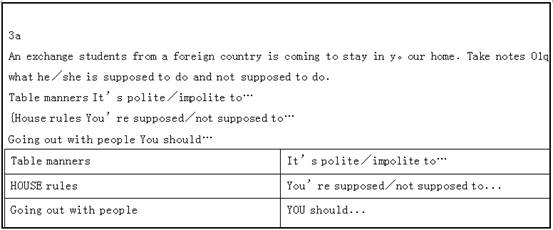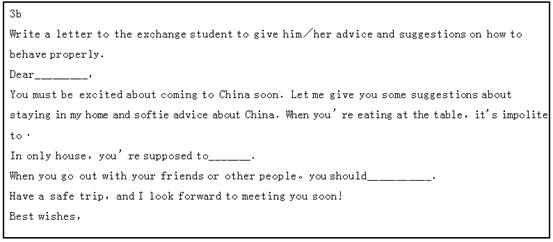当前位置:首页 → 职业资格 → 教师资格 → 中学英语学科知识与教学能力->根据提供的信息和语言素材设计教学方案。用英文作答。设计任务:
根据提供的信息和语言素材设计教学方案。用英文作答。
设计任务:请阅读下面学生信息和语言素材,设计一个30分钟的写作教学活动。
教案没有固定格式,但须包含下列要点:?
teaching objectives
teaching contents
key and difficult points
major steps and time allocation
activities and justifications
教学时间:30分钟?
学生概况:某城镇普通中学九年级(初中三年级)学生,班级人数40人,多数学生已经达到《义务教育英语课程标准(2011年版)》三级水平,学生课堂参与积极性一般。
语言素材:

Teaching Content: A class about how to writing.
Teaching Objectives:
(1) Knowledge objectives:
① Students will be able to know more Chinese customs, such as table manners, house rules, going out with people.
② Students can give some advice and suggestions about some Chinese customs to foreigners.
(2) Ability objective:
Students will improve their writing skills of giving advice and suggestions and improve the ability of communication.
(3) Emotional objectives:
① Students will have a deep understanding of the customs in our country.
② Students will foster their cross-cultural communication awareness.
Teaching Key Points:
How to give advice and suggestions on the rules of Chinese customs: table manners, house rules, going out with people.
Teaching Difficult Points:
How to master the expressions of Chinese customs and tell them to foreigners by letter.
Teaching Procedures:
Step 1 Pre-writing (10 minutes)
(1) Students are divided into ten groups. The teacher asks them to read 3a and discuss how to complete the chart. Then the students are asked to present their results and the teacher concludes their answers on the blackboard.
(2) Pair work
The teacher asks students to make a dialogue with their deskmates using the expressions:
①--What are the table manners
--It's polite/impolite to ...
②--What are the house rules
--You're supposed/not supposed to ...
③-How about going out with people
--You should ...
After the practice, the teacher invites two pairs to display their dialogue in the front of the class.
(Justification: This step can make students feel interested in the class and have things to write.)
Step 2 While-writing (15 minutes)
(1) Drafting
The teacher asks students to complete the letter of 3b according to the expressions in the chart. Then gives students 7 minuties to write the first draft.
(Justification: At this stage, the development of ideas are more important than getting grammatical structures, punctuation or spelling correct.)
(2) Peer editing
After the drafting, the teacher asks students to check each other's articles. They should read the notice and check the formation and the expressions. Also, they need to check carefully the grammar, spelling and punctuation of their writings. During the editing activity, the teacher offers guidance to students.
(Justification: Peer editing can provide an opportunity for students to share their writings and help them learn from each other. Proper guidance in revising can help students to know how to develop ideas and how to write clearly.)
Step 3 Post-writing (5 minutes)
The teacher invites two students to show their passages to all the students and gives them some evaluations.
Students will be encouraged to give some assessments too. Then the teacher asks students to revise their articles in both organisation and content based on the evaluations.
(Justification: At this stage, students can get some improvements in both organisation and contents. Revising their own articles can make them realize their mistakes more clearly.)
教师职业道德区别于其他职业道德的显著标志就是( )。
《普通高中数学课程标准(实验)》提出五种基本能力,没有包含在其中的是
"三五步行遍天下,六七人百万雄兵”描写的是( )。
在教育史上主张“不愤不启,不悱不发”的教育家是()。
心理学家所说的“危险期”或“心理断乳期”是指( )。
教育工作中做到“因材施教”、“长善救失”符合年轻一代身心发展的( )。
德育过程与品德形成过程的关系是( )。
德育过程是培养学生( )的过程。
学生从事集体活动、结交好友的场所是( )。
教师的工作目的和使命是( )。